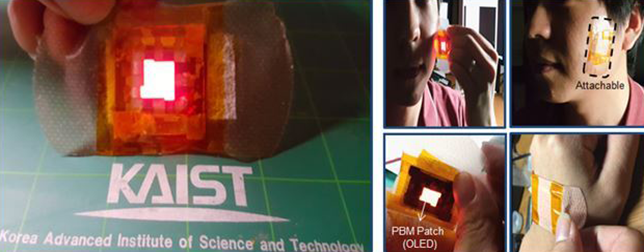A team of scientists from South Korea have developed an innovative wearable patch that attaches to the skin to heal wounds regardless of location or time. The “OLED patch” treats injuries using an organic light-emitting diode source aimed at damaged areas. OLEDs are normally used in electronic devices, but this is the first time it has been used as a therapy.
The device uses a method known as photobiomodulation (PBM), a light therapy that utilizes lasers or light-emitting diodes to boost tissue repair and reduce inflammation and pain. The researchers designed the OLED patch as an easy, portable tool for delivering PBM.
Read more BioSensics Launches Digital Platform for Clinical Trials
PBM has long been considered a safe and noninvasive method of stimulating tissue regeneration. Yet, conventional PBM devices using pointed light sources, such as light-emitting diodes (LEDs) and lasers, are usually inflexible, too heavy, and difficult to irradiate light uniformly. They may also produce localized heat. Due to these restrictions, it was difficult to improve the clinical effects of LED devices as they cannot adhere to the body.
Overcoming such disadvantages, the team led by Jeon Yong-min from Korean Advanced Institute of Science & Technology (KAIST) and Choi Hye-ryung from Seoul National University Bundang Hospital, developed a wearable PBM patch using a “flexible red-wavelength OLED surface light source, which can be attached to the human body,” according to the research paper.

The tiny OLED patch fits in a palm, it’s also flexible, lightweight, and durable. With a thickness of just 676 micrometers, it weighs only 0.82 grams. The patch can be used for more than 300 hours, and can bend along a curve with a 20 millimeter radius.
The temperature of these patches remain below 40 degrees C at all times, eliminating risks of a first-degree burn.
Read more Wearable Digital Thermometer Detects Fever Quicker than Current SOC method
They also meet the safety regulations of the International Organization for Standardization (ISO) at red wavelengths (600–700 nm).
In the study, the wearable PBM patches showed outstanding effects with in vitro wounds because they stimulated fibroblast proliferation by over 58% of control as well as fibroblast migration by over 46% of control, proving its effectiveness in tissue regeneration.
“Once commercialized, our patch will enable patients to receive light therapy conveniently,” said lead author Jeon via the National Research Foundation of Korea.
“By controlling the amount of the emitted light, we can also extend the product’s use to include not just skin regeneration, but also treating conditions like skin cancer, Alzheimer’s disease and depression.”
The findings were published in the academic journal Advanced Material Technologies.












